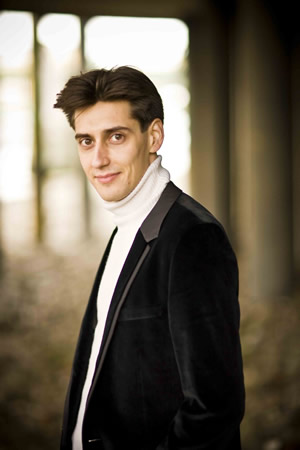It was well worth arriving extra early to find parking for the choice all Russian program presented by the North Carolina Symphony in the refined acoustics of Meymandi Concert Hall. This second concert in Raleigh’s Classical Series presented the Janus-like aspects of two very different 20th-century composers, Sergei Rachmaninoff (1873-1943) and Dmitri Shostakovich (1906-75). The older Rachmaninoff “looked back” to the rich Romantic scoring of Brahms and Tchaikovsky. The younger Shostakovich “looked forward” to adapting acerbic “modern” elements to a continuation of the Romantic symphony from such exponents as Mahler.
One of the mature Shostakovich’s lesser efforts, the “Festival Overture,” Op. 96, was a very effective warm up for the rest of the evening. It is one of many small occasional pieces, a composer’s “daily bread,” in this case commemorating the 37th anniversary of the Russian Revolution; it was premiered on November 7, 1954. It has a jaunty tune and showy work for the brass and has been a popular work ever since. Music Director Grant Llewellyn led the orchestra in a rousing performance.
Shostakovich’s great genius was already apparent in his Symphony No. 1 in F Minor, Op. 10. The 19-year-old composer had just completed his studies at the Leningrad Conservatory in early 1925, and this was his graduation exercise. His family could not afford the expense of printing the orchestral parts, but his talent was so promising the conservatory paid for the scores. It was premiered May 12, 1926. While the work is grounded in the Russian traditions of Rimsky-Korsakov, Glazunov, and Tchaikovsky, there is more than a leavening of modernist influences with its acerbic harmonies and odd twists and turns of melodic lines. It is in four movements: a spiky, sassy first movement, a sardonic scherzo, a haunting lento which anticipates the mature composer, and a similarly anticipatory dramatic finale.
Llewellyn and his musicians played the socks off this marvelous early symphony. The list of the many superb section solos would be quite long. Concertmaster Brian Reagin had significant solos throughout movements two through four, as did associate principal cellist Elizabeth Beilman, not least the heartfelt cello solo after the thundering timpani episode, played by principal John Feddersen at the pivotal turn of the finale. Other fine efforts came from principal flutist Anne Whaley Laney, principal oboist Melanie Wilsden, principal bassoonist John Pederson, assistant principal clarinetist Michael Cyzewski, and principal horn Rebekah Daley. The extensive trumpet solos throughout all four movements were played brilliantly by principal trumpeter Paul Randall.
The “Meet the Artist” pre-concert feature on Friday night was well worth attending. It featured solo pianist Yevgeny Sudbin, who was making a welcome return as a guest artist. His comments about aspects of the score and of preparing to play the Piano Concerto No. 3 in D Minor, Op. 30 (1909), by Rachmaninoff, were of particular interest. In the early days, cuts in the score were often made, even by the composer/pianist himself. The score contains alternate passages, not least the two different cadenzas, one longer and more daunting than the other. Sudbin said the composer chose the shorter one when he played the piece. The post-WWII rise of the HIP (Historically Informed Practice) movement bought a level of puritanism which has ironically led to the current practice of playing Rachmaninoff’s scores complete, with all the cuts opened. Sudbin said he had not decided which of the two massive first movement cadenzas he would opt for in this concert, which is the first time he will have played the work in concert. This is in anticipation of a future recording of the work to complete the concertos for the label BIS.
The well-known concerto is in three long movements: a haunting opening allegro, a melancholy intermezzo, and a dashing, brilliant finale.
Llewellyn led the orchestra in an accompaniment that fitted Sudbin’s solo work like a glove. Dynamic balance was excellent, with refined dynamics and great care for orchestral color. The low strings produced some fine, rich passages, and there were some really subtle efforts from the horns, just to mention a few of the sections. While there was no lacking of power or digital dexterity in Sudbin’s interpretation, my predominant impression was one of great delicacy and poetry in the many quieter passages. This was a fine start and it would be fascinating to have him return with the piece in a few years when he gets ready to commit it to a recording.
This program will be repeated on October 4. For details, see the sidebar.












